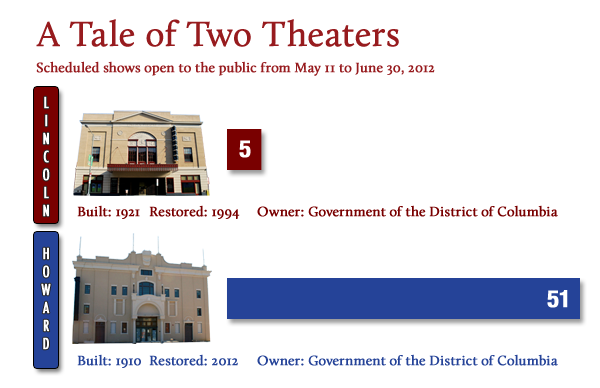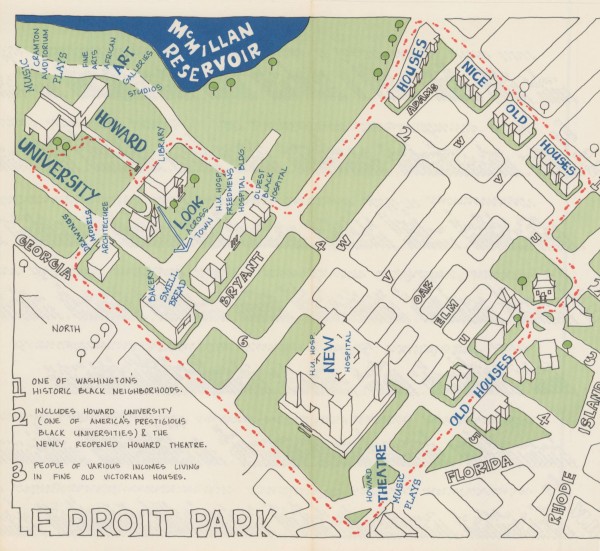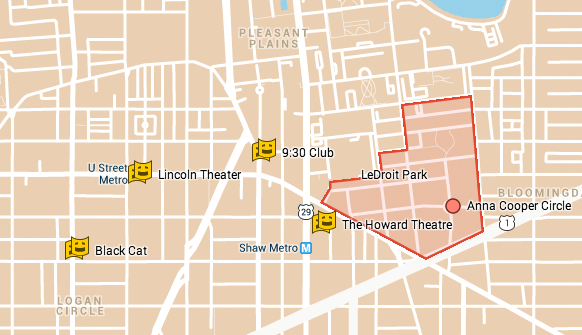A bicentennial map depicts LeDroit Park in 1975
DDOT posted this map of DC published in 1975 to celebrate the bicentennial. The map includes a section on LeDroit Park. Notice the groovy font, the “new” Howard University Hospital, the “nice old houses”, the long-gone bakery, and the “newly reopened Howard Theatre.” The Howard Theatre had briefly reopened from 1975 to 1980.
The Lincoln Theater is back in business

Photo by NCinDC on Flickr
The Post reports that music venue owner IMP, which operates the 9:30 Club and Merriweather Post Pavilion, is now managing the District-owned Lincoln Theater.
As we noted before, the Lincoln Theater’s revival in the 1990s failed to measure up to the Howard Theatre’s recent rebirth. Last year we compared the number of scheduled events at both theaters from May 11 to June 30, 2012. The contrast was stunning as the Howard had announced 51 scheduled events compared to the Lincoln’s paltry five.
The District’s new operator for the Lincoln has already booked comedians Ira Glass and Cheech and Chong, as well as musical performers Janelle Monae, Soundgarden’s Chris Cornell, and KT Tunstall for next month.
The Lincoln is just one of four big venues within a mile of LeDroit Park:
| Theater | Distance | Capacity |
|---|---|---|
| Howard Theatre | 0.3 mi | 600 if seated; 1,000 if standing |
| 9:30 Club | 0.6 mi | 1,200 standing |
| Lincoln Theater | 0.8 mi | 1,225 seated |
| Black Cat | 1.0 mi | 700 standing and 200 in the backstage |
The Lincoln Theater’s 1,225 fixed seats set the venue apart. Though this configuration limits the types of acts that will perform, it also guarantees each patron a reserved space.
Check out the Post’s handy comparison chart, including typical headliners and food options for each venue.
The Lincoln vs. the Howard: What a difference operations make

The revival of the Howard Theatre brought worry that our newly revived venue would follow the disappointing path of the Lincoln Theatre on U Street. After all, both theaters were built in the early 20th century, both are owned by the DC government, and both are located within a short walk of each other.
A glance at both theaters’ online schedules reveals that their fates have sharply diverged. From now until the end of June, the Lincoln Theatre has 5 events scheduled while the Howard has 51.
This glaring disparity shows the importance of selecting the right management team. The District chose the experienced Blue Note Entertainment Group to run the Howard while it chose the non-profit U Street Theatre Foundation to run the Lincoln. The mayor’s office rightly revoked U Street Theatre Foundation’s contract for the Lincoln as the theatre was careening toward bankruptcy at the end of 2011. The mayor has tasked the DC Commission on the Arts and Humanities with finding a new operator for the Lincoln.
The greater U Street area is a regional arts venue. The Howard Theatre, the 9:30 Club, U Street Music Hall, the Black Cat, Bohemian Caverns, Twins Jazz Club, and numerous performance-oriented bars provide an amount of live performance space most cities would envy. But when we compare the success of these venues to the fiasco of the Lincoln Theatre, it becomes clear that something is terribly wrong in the District’s stewardship of this resource. If all of these venues can thrive, so can the Lincoln.
The Howard is open!
Last night the Howard Theatre held its grand opening concert featuring the musical talents of Trombone Shorty and the eminent George Clinton. After a 30-year hiatus, the century-old historic theater’s comeback has left everyone gobsmacked.
The interior is beautiful, featuring walnut panelling, tasteful lighting, and blown up shots of famous performers who made their names at the Howard. The lower floor is mostly an open concert floor, with booths and a bar on an elevated perimeter. The balcony level features a long bar, numerous tables, and banquettes that provide an superb view of the stage. Of all the articles we’ve read online, Brightest Young Things has the best photos of the interior.
The Howard’s schedule is packed with a variety of acts and with its location just a short walk from home, you have every reason to visit.
City Paper contrasts the Howard and the Lincoln
We wrote before about how the Howard Theatre differs significantly from the often-dark Lincoln Theatre on U Street. Now the City Paper published a longer essay contrasting the theaters and showing that the Howard will not repeat the mistakes of the Lincoln. According to the City Paper, there are six main reasons that the Howard will likely succeed where the Lincoln failed:
- The Howard will book a variety of popular acts, including acts that typically perform elsewhere.
- A professional management company with a history of running music clubs will manage the theater.
- The Howard can convert from a standing-room venue to a seated supper club in a flash. The Lincoln Theater’s seats, by contrast, cannot be removed.
- The Howard will serve much more food and, more importantly, alcohol, which is where profits are made in the restaurant business.
- The District government, though holding title to the property, has little influence in its operations.
- The Howard has better developed PR and marketing strategy.
Neighbors reminisce about the Howard Theatre
 In preparation for the Monday’s grand (re)opening of the Howard Theatre, the Post ran a story about the theater’s past and how the Shaw and LeDroit Park have changed over the decades since the theater’s heyday.
In preparation for the Monday’s grand (re)opening of the Howard Theatre, the Post ran a story about the theater’s past and how the Shaw and LeDroit Park have changed over the decades since the theater’s heyday.
The article also describes the histories of some long-time local businesses, including the Hall Brothers Funeral Home, the HJM Variety Shop, and Gregg’s Barber Shop.
A neighbor we know who studies local history likes to ask long-time residents if they feel the city has lost anything with the influx of residents, wealth, and investment over the past 15 years. Inevitably, the answer is yes and the answers differ to some degree.
The Post article is striking in that the residents who remember the theater in its golden age don’t expect its current incarnation to live up to the excitement of its younger self.
For those Washingtonians, the Howard’s rebirth stirs a mix of curiosity and excitement for what is new, and nostalgia and melancholy for what has been lost.
“It looks like a mausoleum to me,” said Juan Rosebar, 61, eyeing the theater on a recent afternoon, as workers laid cobblestones on the street outside.
As a kid, Rosebar watched the stars migrate from the Howard to Cecilia’s Stage Door, a bar a few yards away where they’d mix with their fans and drink post-performance cocktails. Cecilia’s closed long ago, as did Jimmy’s Golden Cue, the pool hall across the street where Rosebar learned to hustle. All that’s left is Jimmy’s rusted sign, the letters barely legible.
“You can’t turn the clock back,” Rosebar said. “You won’t get the scene; you won’t get the flamboyance.”
Another resident, Frank Love, concurs:
“It’s all changed around here,” said Love, 77, shaving a customer’s sideburns and listing the names of a half dozen long-gone barbershops. He can’t wait for the Howard’s reopening and the chance to step inside the place where he went to see Jackie Wilson with his future wife, Pearl Love.
He knows the theater can’t be what it was, but he’s okay with that. “That was then, and this is now,” he said. “You can’t look for it to be the same.”
You can tell from the posts on this blog that history fascinates us. However, the study of history is part real and part imagined. Though buildings can be preserved and restored, the people and societies that made them relevant cannot. The Howard will reopen on Monday and it will serve as a lively venue for a diverse array of national acts, but its cultural relevance may never again match its storied past.
Duke Ellington immortalized in stainless steel
The Howard Theatre is nearly complete. You may have noticed that the sidewalk on the north side of T Street is now open, giving residents a close-up view of the new façade. More importantly, the plaza at T Street and Florida Avenue is now open and the new sculpture of Duke Ellington stands prominently at the vegetated plaza. The sculpture depicts Ellington seated on a treble clef while playing a piano keyboard.
The most delightful feature of the sculpture is the energy it portrays. As Ellington plays, the keys appear to fly off the keyboard and into the sky behind him, signifying a magical quality to his music.
Duke Ellington grew up in Washington and even lived on Elm Street in LeDroit Park for a year. He played at the Howard Theatre and frequently visited the adjacent Frank Holliday’s pool hall, most recently known as Cafe Mawonaj.
The hall was a popular gathering spot for Howard scholars, jazz musicians, and city laborers alike. Duke Ellington captured the scene at the pool hall:
Guys from all walks of life seemed to converge there: school kids over and under sixteen; college students and graduates, some starting out in law and medicine and science; and lots of Pullman porters and dining-car waiters.
And now Ellington’s statue sits on the same storied block.
Howard Theatre encourages private parking
To reduce the liklihood that patrons will park on residential streets around the Howard Theatre, the theatre will sell prepaid private parking through Ticketmaster. The passes are for private lots owned by Howard University and other private owners.
In fact, we were looking on Ticketmaster at prices and availability for April’s Wanda Sykes show and spotted this prominent parking add-on at the bottom:

The lots described above are as follows:
- Valet shuttle Lot B – Howard University’s large parking lot at Georgia Avenue and W Street.
- Self-parking Lot A – Howard University’s HURB-I parking lot at 7th & T Streets.
- Premier Valet – private triangle lot at T Street and Florida Avenue, across from the theater.
When Progression Place, the office and apartment project at the Shaw Metro, finally opens, the theatre will lay claim to a significant number of the project’s underground parking spaces during nighttime hours, thus adding a another option.
Howard Theatre ribbon-cutting set for April 9
The Howard Theatre developers want the new interior to come as a surprise on opening day, so they are not letting people take photographs inside right now. Nonetheless, the City Paper described it as “opulent”.
The ribbon-cutting, which is open to the public, will be on Monday, April 9 from 11:30 am to 3 pm. You can get a tour of the theater and witness the unveiling of the Duke Ellington statue for the plaza and the “Jazz Man” sculpture on the cornice.
Will the Howard Theatre go the same way as the Lincoln Theatre?
Will the Howard Theatre, soon to open in April, end up bankrupt like the Lincoln Theatre on U Street? Both are historic U Street area theaters that were revived at significant public expense. Both are owned by the District government and are under the control of non-profits.
There are, however, some significant differences between the Lincoln and the Howard: the floor, the kitchen, and the management.
The Lincoln Theatre is a traditional theater with fixed rows of seats. This makes the venue unsuitable for a variety of performances. All concert venues nearby have few if any seats— just an open floor where patrons stand.
The Howard Theatre’s floor is a little different. The theatre will have few permanent seats. Much of the space will contain seats and tables for the performances where food is served, such as the weekly gospel brunch, a comedy show, or certain jazz performances.
When tables are unsuitable for the type of performance, they will be stowed beneath the stage, thus opening up the first floor like the 9:30 Club or the Black Cat. This flexibility allows the venue to attract a greater variety of acts.
Another important difference is that the Howard Theatre will contain a large kitchen. Food service, particularly on the sale of alcohol, is where the venue will make money. The Lincoln Theatre’s food and liquor operation can’t compare.
Finally, while the Lincoln Theatre was managed (or mismanaged, some say) by an ad hoc non-profit, the Howard Theatre will be run by Blue Note Jazz Clubs, which runs the Blue Note Jazz Club, the Highline Ballroom, and B.B. King Blues Club & Grill in New York. This gives us confidence that a similar success can happen at the Howard.

















Recent Comments